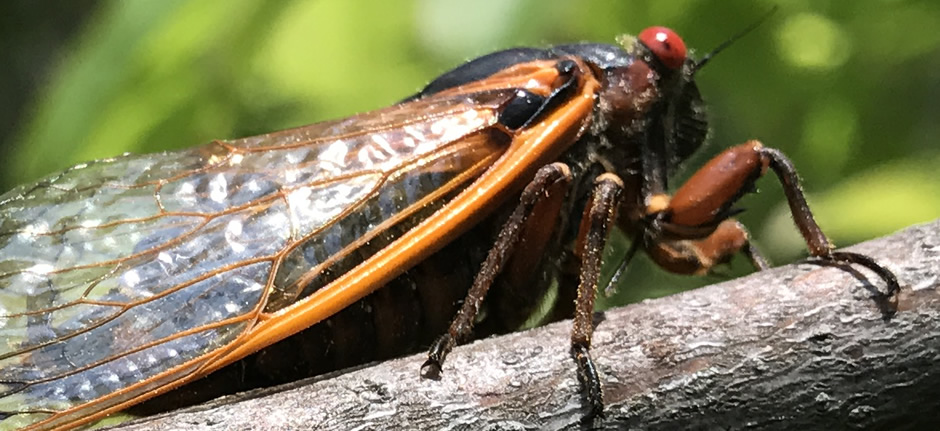This morning on Nature News Carlton Burke and Dan Lazar took us on a field trip to hear Brood VI of the 17 Year Periodical Cicada.
Nature News is a local AM radio show that tells what is going on in nature locally. It comes on AM 1600 every Saturday at 7:00 AM. You can also listen to it live on the WTZQ website. Each week’s program is put on the Nature News page of the site, so you can listen to it later if you miss it.
www.wtzq.com/naturenews.html
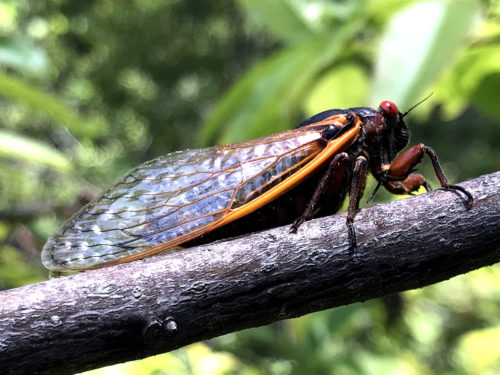
On May 13 Dan and Carl had reported on the earliest arrival of the cicadas. On May 20, they explained exactly where they went on their field trip, vacant land just east of Hobby Lobby, on Airport Road, so we headed over there. This is some of the video.
They explained that this was an aggregating area for male 17 year cicadas, with millions per acre.
Things I learned from this episode of Nature News:
- Cicadas are classified as true bugs because they have piercing and sucking mouth parts
- Periodical Cicadas look like enormous house flies with red eyes.
- When they are underground they live off the fluid in the roots of trees. They are “sapsuckers.”
- When they are underground, the nymphs are the size of an ant.
- Periodical Cicada are synchronized. They rest a few inches below the surface of the ground until the surface temperature is around 65°, then they emerge simultaneously, sometimes all on the same night.
- When they emerge, they shed their nymphal exoskeleton. The skin splits and wings emerge. As they pump fluid in the wings they elongate. Within a few hours they harden. From living under ground for 17 years, suddenly they are in the light and can fly!
- They are living and singing for two or three weeks.
- They suck some from the trees, but they don’t injure them.
- The females make little slits, which may cause the end of a twig to die back, but that doesn’t really hurt the tree either.
- The incessant droning, which sounds like a flying saucer, is made by the male pumping air through an empty hollow chamber.
- They also make distress calls and talk to girl cicadas with a different call. It sounds a little like a cat meow.
- Brood VI of the 17 Year Periodical Cicada is a very small brood in distribution. It is a very narrow scattered band that doesn’t reach into Asheville.
- The big brood around here is Brood 14. It emerged in 2008. (I remember that.)
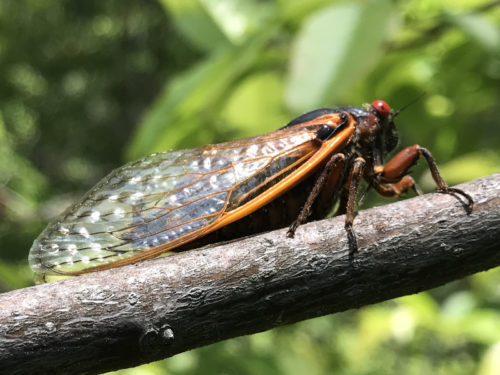
More about Cicadas
Not all cicadas are Periodical Cicadas. Most of the cicadas around us are annual cicadas, in the genus Neotibicen. They emerge in late July and August.
Periodical Cicadas are in the genus Magicicada. They have a 13 or 17 year life cycle.
Cicadas do not “fiddle,” like crickets. They have tymbals, thin vibrating membranes and resonance chambers below each side of their front. Only males make that sound. They are loud!
“The tymbals are structures of the exoskeleton formed into complex membranes with thin, membranous portions and thickened ribs. Contraction of internal muscles buckles the tymbals inwards, thereby producing a click; on relaxation of the muscles, the tymbals return to their original position, producing another click. The male abdomen is largely hollow, and acts as a sound box. By rapidly vibrating these membranes, a cicada combines the clicks into apparently continuous notes, and enlarged chambers derived from the tracheae serve as resonance chambers with which it amplifies the sound. The cicada also modulates the song by positioning its abdomen toward or away from the substrate. Partly by the pattern in which it combines the clicks, each species produces its own distinctive mating songs and acoustic signals, ensuring that the song attracts only appropriate mates.”
Cicadas are among the loudest insects. They are so loud they actually turn off their “ears,” called tympana when they call, so they won’t deafen themselves.
Cicadas do not sting. They could bite, they do have mouths, but you’d really have to annoy one. They are not venomous and they don’t seem to transmit anything. Still. It would hurt, so I wouldn’t do it.
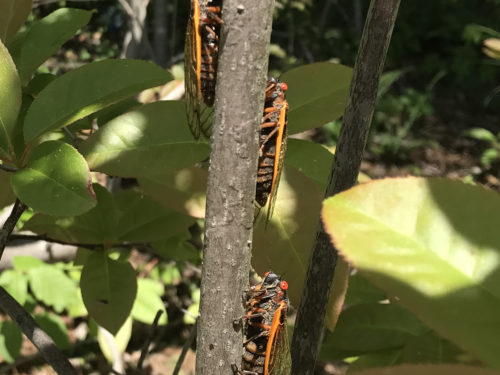
The Life of a Cicada
The female cicada lays her eggs in a slit in the bark of a tree.
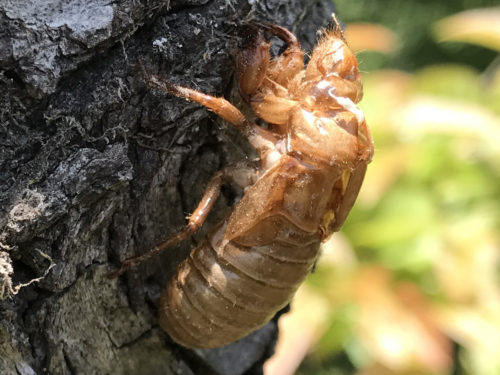
See the front claws they use to dig to the surface?
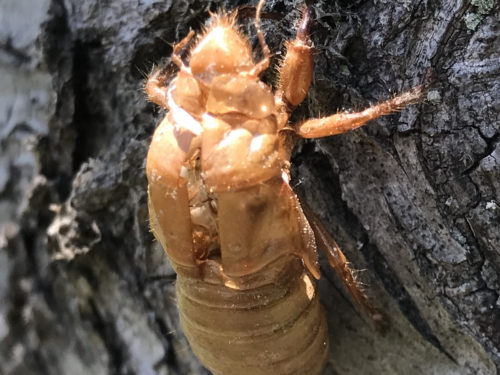
When the eggs hatch, the nymphs fall out of the tree and burrow down eight feet. They dig a chamber near roots and live off the sap of the tree as they grow. When it’s time, they dig their way out. They climb up whatever handy plant or tree is nearby and molt. They leave the empty exoskeleton attached to the tree. When they first molt, they are white, but they darken within an hour. It takes six days for their exoskeleton to harden completely. The adult cicada has wings.
Most cicadas do this every year. Some cicadas have a life cycle of 13 or 17 years. Periodic cicada nymphs move deeper as they grow older. They spend that long underground, then all emerge at the same time. After so long underground, they spend only four to six weeks active above ground.
Entomologist C. L. Marlatt assigned the numbers to the Periodic Cicada broods. In 1898, he listed 30 different broods and assigned numbers to them; 17 broods for the 17-year lifecycles, 13 broods for the 13-year lifecycles. Some broods he theorized have not (so far) been found. Two broods were observed, but now seem to be extinct. There seems to be only fifteen broods, but we still use Marlatt Broods to distinguish Periodical Cicadas.
You can find a list of the broods, their emergences and location on Wikipedia: wikipedia.org/wiki/Periodical_cicadas
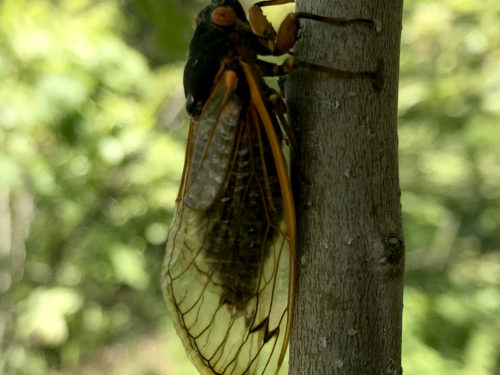
Want to see this phenomena? The Forest Service has prepared a map and schedule.
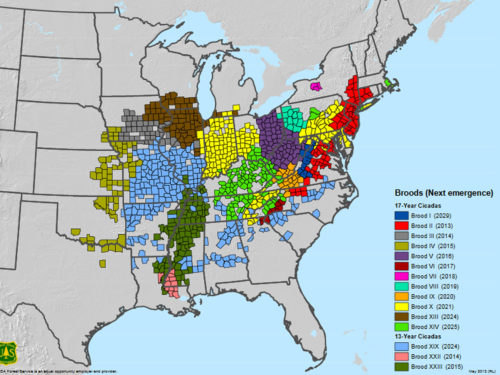
Map of Active Periodical Cicada Broods of the United States
Andrew M. Liebhold, Michael J. Bohne, and Rebecca L. Lilja
USDA Forest Service Northern Research Station and Northeastern Area State &
Private Forestry, May 2013

